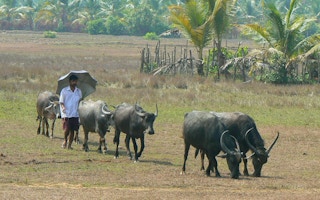In late March, an Indian teenager, Saheba Dehury, was undergoing physical tests for a home security job in the eastern state of Odisha. The 19-year-old collapsed abruptly, presumably due to extreme heat, when the temperature was hovering around 35°C.
To continue reading, subscribe to Eco‑Business.
There's something for everyone. We offer a range of subscription plans.
- Access our stories and receive our Insights Weekly newsletter with the free EB Member plan.
- Unlock unlimited access to our content and archive with EB Circle.
- Publish your content with EB Premium.
With no proper medical attention, Dehury died the next day in hospital and, in all likelihood, the death was registered as an episode of non-heat-related causes.
Sadly, Dehury’s demise may be just the first of hundreds, if not thousands, of deaths waiting to occur as India’s scorching summer is set to worsen in the coming weeks.
With no heat-specific, coherent policy for the country’s 1.4 billion people and ill-prepared local governments pulling in different directions, heat-related casualties are set to become one of the administration’s most pressing challenges in the coming months.
From April to June, most parts of north and east India, central India, and the plains of northwest India are expected to experience two to four more heatwave days than normal, Mrutyunjay Mohapatra, chief of the nodal weather agency India Meteorological Department (IMD), said during a press conference on 31 March.
“During heatwaves, elevated temperatures pose significant risks, especially for vulnerable populations like the elderly, children, and those with pre-existing health conditions, who are more susceptible to heat-related illnesses such as heat exhaustion and heatstroke,” he added.
The months of February and March witnessed spells of unusually hot weather, with many Indian states registering their hottest-ever temperatures for these months in recorded history. On average, a rise of 1-3°C from the normal temperature was reported across several states.
Heatwaves or severe heatwave conditions are already prevailing in several northern and western states.
Lack of coordinated policy
India’s vast and varied geography – from the Himalayas to tropical coastlines – has not spared any inhabited region from the growing impacts of rising temperatures in recent years.
In addition to taking a brutal toll on sectors like agriculture, hundreds die each year from heat, with the death toll rising steadily.
Most experts believe there is a serious undercounting of heat-related deaths due to inaccurate reporting systems, poor data collection, and a lack of awareness.
India’s heat action plans remain largely advisory, lacking enforceable measures such as restricting outdoor work during peak hours or mandating access to hydration. Worse, many of these plans exist only on paper with minimal or no implementation.
Estimates suggest that over 50 per cent of the country’s GDP is generated by workers in heat-exposed conditions, with limited or non-existent safety nets.
According to official figures, there were 48,000 suspected heatstroke cases, 269 suspected deaths, and 161 confirmed heatstroke deaths last year. However, independent experts say the true toll is far higher.
For instance, the monitoring agency Heat Watch reported at least 733 heatstroke deaths in 2024. Many of those affected had pre-existing conditions, making it difficult to accurately determine the actual cause of death.
State versus centre: a policy divide
A senior federal government official acknowledged the scale of the problem but pointed to India’s decentralised governance as a constraint.
“We do understand the impact of climate change and extreme heat is brutal and needs to be addressed. But most of these should be dealt with by the state governments, and we could only offer guidelines at this stage,” said the official under the condition of anonymity.
Sustainable Futures Collaborative, a research organisation, recently published a report assessing how well India is prepared for a warming world. The report focused on cities and urban populations and offered several urgent recommendations.
“It’s one of the major findings of the report. Every city is more focused on short-term measures. This is in itself a success story because no one knows how much is happening on the ground. At least the bureaucrats and policymakers are thinking about heat waves as a problem to deal with,” said Tamanna Dalal, one of the authors.
“The future is kind of already here. Even if the short-term measures are implemented and executed well, we believe that they won’t be enough because the long-term focus is so lacking,” she added.
Other environmental experts argue that India must address the root causes of extreme heat by holding climate-abusing industries to account, rather than treating heat waves as isolated events.
Grant Ennis, author of Dark PR and lecturer at the Melbourne-based Monash University, placed direct blame on the fossil fuel industry and its deceptive practices for exacerbating the crisis.
“All countries in the world, and people in all countries, will suffer from increasing global warming. According to the International Monetary Fund, in 2025 India will provide US$414 billion or 10 per cent of GDP in incentives or subsidies for fossil fuels. We could stop paying more and more every year in the form of government incentives and subsidies that cause global warming,” said Ennis.
Asked how the fossil fuel industry promotes false solutions, Ennis pointed to the “carbon footprint” narrative as a key example.
“BP popularised the concept of the carbon footprint in the early 2000s to decrease support for political action. This framing of blaming the individual for global warming has been used by actors who have profited from global warming ever since. The implications are shocking as this individualisation has distracted humanity from the fact that every year our governments increase subsidies for fossil fuels, and very little is being done to stop it,” said Ennis.
Meanwhile, as one of the world’s most vulnerable countries to extreme heat braces itself for a period of high temperatures, scientists project the number of hot days and hot night events in India will increase by between two and four-fold by 2050. Heatwaves are also expected to start earlier, last longer and become more frequent.










